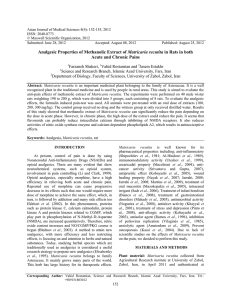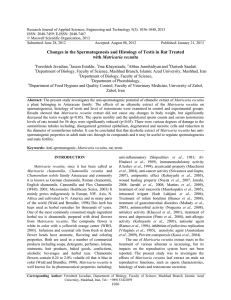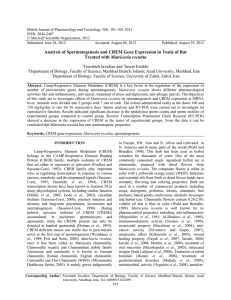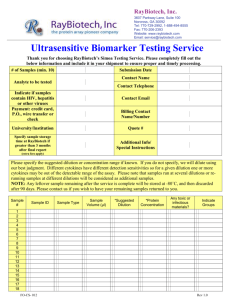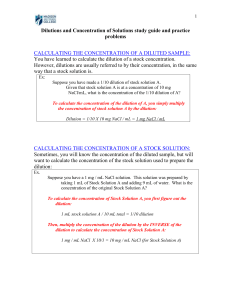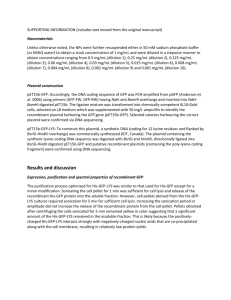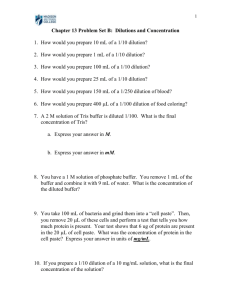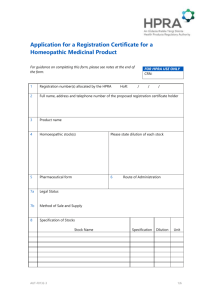Matricaria recutita
advertisement
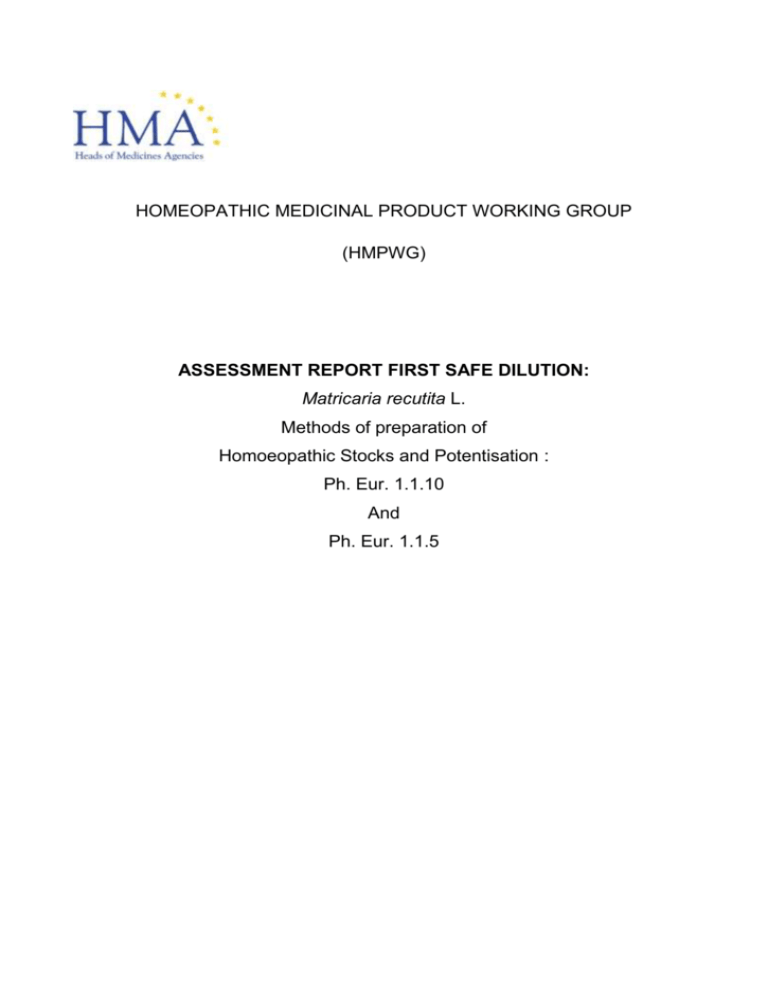
HOMEOPATHIC MEDICINAL PRODUCT WORKING GROUP (HMPWG) ASSESSMENT REPORT FIRST SAFE DILUTION: Matricaria recutita L. Methods of preparation of Homoeopathic Stocks and Potentisation : Ph. Eur. 1.1.10 And Ph. Eur. 1.1.5 Table of contents 1. General data ............................................................................................................................................ 3 1.1. Name of the Stock / Raw/ Starting Material, and Synonyms if applicable ........................... 3 1.2. Definition of the Stock /Raw/ Starting Material ......................................................................... 3 1.3. Monograph European Pharmacopoeia/ official national pharmacopoeias if available: ...... 4 1.4. Other specifications: ..................................................................................................................... 5 2. Criteria for the establishment of a first safe dilution .......................................................................... 5 3. Allowed as food or constituent of food ................................................................................................ 5 4. Authorised allopathic medicinal product (Non-genotoxic, Non-carcinogenic, Non-Teratogenic) 6 5. Toxicological data ................................................................................................................................... 6 6. Integrated risk assessment of the raw material and medicinal end product .................................. 6 7. Acceptable amount (mg/kg/day) based on stock/raw /starting material/compound (to be specified) .......................................................................................................................................................... 6 8. First Safe Dilution.................................................................................................................................... 6 2 ASSESSMENT REPORT TEMPLATE FIRST SAFE DILUTION 1. GENERAL DATA 1.1. Name of the Stock / Raw/ Starting Material, and Synonyms if applicable - Raw material: Chamomilla vulgaris for homœopathic preparations (France) Preparation of mother tincture according to method 1.1.10 (Ph. Fr.) of the Ph. Eur. Raw material: Matricaria recutita Production of mother tincture and liquid dilutions according to method 1.1.5 (formerly methode 3a of GHP) of the Ph. Eur 1.2. Definition of the Stock /Raw/ Starting Material Raw plant material: Fresh whole flowering plant of Matricaria recutita L. - Name of the plant (binomial name (genus, species, author) and synonyms): Matricaria recutita L. (Asteraceae) Synonyms: . Chamomilla meridionalis C. Koch . Chamomilla vulgaris Gray . Chamomilla officinalis C. Koch . Chrysanthemum chamomilla Bernh. . Chrysanthemum suaveolens (L.) Cavan. . Leucanthemum chamaemelum Lam. . Matricaria chamomilla L. . Matricaria coronata Gay ex Koch . Matricaria pusilla Willd. . Matricaria suaveolens L. - Part(s) of the plant used: Whole flowering plant - State of the plant (dry or fresh): Fresh - Homeopathic Manufacturing Method/Method of preparation: - European Pharmacopoeia (Ph. Eur.) in force monograph 2371: Methods of preparation of Homoeopathic Stocks and Potentisation :Ph.Eur. 1.1.5 or Ph. Eur. 1.1.10; - Ph. Eur. monograph 2029: Mother Tinctures for Homoeopathic Preparations. - Toxic Components: - Chamomilla oil: substance generally recognized as safe – GRAS-Status (http://www.libertynatural.com/info/eoinfo/FDA_EO_GRAS.htm) Matricaria flowers: - cumarins : according to Redaelli C, Formentini L, Santaniello E (1981) Planta Med 43:412–413 the content of cumarins has to be corrected in the following way: umbelliferon 0,01%, herniarin 0,06%, total content 0,07% cumarins - 0.24-1.9% essential oil of which main components are (-)-α-bisabolol (up to 50%) and chamazulene (1 – 15%) (ESCOP monographs, second edition p312); - 8% of flavonoïds of apigenin and its glycosids are the most important component (up to 5% in the fresh plant) Rest of Matricaria plant (leaves, stems and roots): The oils of leaves, stems and roots are devoid of chamazulene and a large variation in the composition of these oils is observed. Limonene is found in high concentration in the oil of stems, whereas (E)- -farnesene is present in large amounts in the leaf and root oil. (http://www3.interscience.wiley.com/journal/88013908/abstract) Limonene (found in high concentration in the oil of stems of Matricaria): Due to evaluation based on background exposition in food the formerly established ADI was withdrawn by JECFA 1993 (http://www.inchem.org/documents/cicads/cicads/cicad05.htm). Therefore Limonene is regarded as non-toxic. - The sesquiterpene α-farnesene (is present in large amounts in the leaf and root oil of Matricaria) accumulates in the peel of many apple and pear cultivars during low-temperature storage and it is responsible for the characteristic green apple odour (http://pubs.acs.org/doi/full/10.1021/jf960780o). No mentioning of toxicity was found in the literature for this substance. - The roots contain especially many phenol acids. They are frequently found in plants showing no toxicity. 1.3. Monograph European Pharmacopoeia/ official national pharmacopoeias if available: European Pharmacopoeia 6.0 (01/2008: 0404) Matricaria liquid extract National: French Pharmacopoeia (10th Edition): Chamomilla vulgaris for homoeopathic preparations: German Pharmacopoeia (2009 Edition) : Matricaria recutita 4 1.4. Other specifications: Whole Matricaria plant: - Chamomilla belongs to the list of substances for which no maximal values of residues are needed “annex 2 of the regulation COUNCIL REGULATION (EEC) No 2377/90 of 26 June 1990 laying down a Community procedure for the establishment of maximum residue limits of veterinary medicinal products in foodstuffs of animal origin”. Therefore, it’s rationale to using the reference to flowers for the whole plant and so we can classify chamomilla as food. 2. CRITERIA FOR THE ESTABLISHMENT OF A FIRST SAFE DILUTION Allowed as food or constituent of food (Please proceed to 3. Allowed as food or constituent of food) Maximum amount of raw material ≤0.15.10-3 mg/60 kg BW/day (TTC) and phytochemical or chemical characterization available Authorised allopathic medicinal product (non-genotoxic, non-carcinogenic, non-teratogenic) (Please proceed to 4: Authorised allopathic medicinal product) Toxicity data available (Toxicological monograph, Pharmacopoeia monograph, Scientific literature) o PDE o TTC (Please proceed to 5. Toxicological Data) Toxicity data unavailable with sufficient phytochemical or chemical characterisation provided o TTC Toxicity data unavailable without sufficient phytochemical or chemical characterisation provided o 3. CH 12/ DH 24 ALLOWED AS FOOD OR CONSTITUENT OF FOOD Chamomilla oil (contains up to 50% α-Bisabolol, see 1.2 Toxic components) has the GRAS-Status. Chamomilla flowers are part of list 3 of the Royal Decree of 29 Augustus 1997 on manufacture and trade of food stuffs composed or containing plants or plant preparations. 5 (KONINKLIJK BESLUIT van 29 AUGUSTUS 1997 betreffende de fabricage van en de handel in voedingsmiddelen die uit planten of uit plantenbereidingen samengesteld zijn of deze bevatten – Arrêté Royal du 29 août 1997 relatif à la fabrication et au commerce de denrées alimentaires composées ou contenant des plantes ou préparations de plantes) Intake is limited per day: fixed maximal amount of ingested α-bisabolol (1.9mg) and apigenine-7-glucoside (5.6mg). 4. AUTHORISED ALLOPATHIC TERATOGENIC) 5. TOXICOLOGICAL DATA 6. INTEGRATED RISK ASSESSMENT OF THE RAW MATERIAL AND MEDICINAL END PRODUCT MEDICINAL PRODUCT (NON-GENOTOXIC, NON-CARCINOGENIC, NON- Given the composition (cfr monographs in annex) of the different parts of chamomilla and the absence of other toxic substances in the leaves, stems and roots than in the flowers, the toxicity of the flowers can be considered for the all plant. 7. ACCEPTABLE AMOUNT (MG/KG/DAY) BASED ON BE SPECIFIED) STOCK/RAW /STARTING MATERIAL/COMPOUND (TO Food legislation: intake limited by limited maximal amount of ingested α-bisabolol (1.9mg) and apigenine-7-glucoside (5.6mg) 8. FIRST SAFE DILUTION 8.1. Methods of preparation of Homoeopathic Stocks and Potentisation : Ph. Eur. 1.1.10 a) FSD in relation to α-bisabolol content, FSD = 1D ; Calculation: Relative content (R.C.) of a α-bisabolol in the plant = approximately 50% of 1.9% (see 1.2) of the plant 0.95% Limited maximal amount of ingested α-bisabolol (LMAI) = 1.9 * 10-3g/jour Dilution factor to prepare the MT = 10 As MT = 0D, no factor is added. 1.9 *10 3 1 LMAI 1 FSD log * * dilution _ factor _ MT log * *10 0.70 1D 0 . 95 R . C . dose _ of _ stock _ in _ 10 ml _ or _ 10 g 10 100 b) FSD in relation to apigenine-7-glucoside, FSD = 2D ; 6 Calculation: Relative content (R.C.) of a apigenine in the plant = maximum 8% (see 1.2) of the plant Limited maximal amount of ingested apigenine (LMAI) = 5.6 * 10-3g/jour Dilution factor to prepare the MT = 10 As TM = 0D, no factor is added. LMAI 1 5.6 * 10 3 1 FSD log * * dilution _ factor _ MT log * * 10 1.15 2 D 8 10 R.C. dose _ of _ stock _ in _ 10ml _ or _ 10 g 100 c) Conclusion Since the concept of FSD takes into account the most conservative approach, the content of the plant in apigenine-7-glucoside is the critcal factor and determine the FSD. FSD Matricaria recutita L. = 2D 8.2. Methods of preparation of Homoeopathic Stocks and Potentisation : Ph. Eur. 1.1.5 a) FSD in relation to α-bisabolol content, FSD = 2D ; Calculation: Relative content (R.C.) of a α-bisabolol in the plant = approximately 50% of 1.9% (see 1.2) of the plant 0.95% Limited maximal amount of ingested α-bisabolol (LMAI) = 1.9 * 10-3g/jour Dilution factor to prepare the As with a hypothetical loss on drying of 60% = 3 2T * 1 7.33 10 100 = D1, a factor +1 is added. 1.9 *10 3 1 LMAI 1 FSD log * * dilution _ factor _ 1 log * * 7.33 1 1.83 2 D 0 . 95 R . C . dose _ of _ stock _ in _ 10 ml _ or _ 10 g 10 100 b) FSD in relation to apigenine-7-glucoside, FSD = 3D ; Calculation: Relative content (R.C.) of a apigenine in the plant = maximum 8% (see 1.2) of the plant Limited maximal amount of ingested apigenine (LMAI) = 5.6 * 10-3g/jour 7 Dilution factor to prepare the As with a hypothetical loss on drying of 60% = 3 2T * 1 7.33 10 100 = D1, a factor +1 is added. LMAI 1 5.6 * 10 3 1 FSD log * * dilution _ factor _ 1 log * * 7.33 1 2.29 3D 8 10 R.C. dose _ of _ stock _ in _ 10ml _ or _ 10 g 100 c) Conclusion Since the concept of FSD takes into account the most conservative approach, the plant content in apigenine-7glucoside is the critical factor and determine the FSD. FSD Matricaria recutita L. = 3D 8

